The Cal Earth Institute is run by Nader Khalili, who has spent his architectural career developing low cost housing techniques using natural earthen materials. His basic goal is to develop techniques for building sustainable, environmentally friendly, affordable housing.
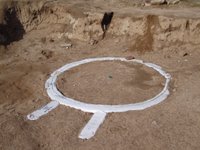 At the Cal Earth Institute he primarily works with superadobe. It is basically 8 shovels of earth/sand/dirt etc., a shovel of cement mix, and a can (the big 6 lbs kind) and a half of water. These ingredients are mixed up either by hand or in a small mixing machine and then poured into sand bags. The sand bags are then laid out into a parabolic dome shape with layers of barbwire between them. The end result is a structure that can be constructed for next to nothing. Once people learn the technique it is possible to build a structure large enough for a family of 4 in
At the Cal Earth Institute he primarily works with superadobe. It is basically 8 shovels of earth/sand/dirt etc., a shovel of cement mix, and a can (the big 6 lbs kind) and a half of water. These ingredients are mixed up either by hand or in a small mixing machine and then poured into sand bags. The sand bags are then laid out into a parabolic dome shape with layers of barbwire between them. The end result is a structure that can be constructed for next to nothing. Once people learn the technique it is possible to build a structure large enough for a family of 4 in 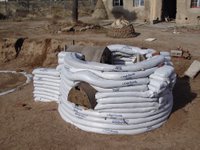 about 2-3 days. Because the structures are made from earthern materials they are very thermally conservative, meaning that if they are heated - even with a small heat source - they stay warm, and vise-versa in terms of cold. In addition, when the structures at the Cal Earth Institute were subjected to a hydraulic earthquake test, not only did they pass with flying colors, they nearly broke the testing machine.
about 2-3 days. Because the structures are made from earthern materials they are very thermally conservative, meaning that if they are heated - even with a small heat source - they stay warm, and vise-versa in terms of cold. In addition, when the structures at the Cal Earth Institute were subjected to a hydraulic earthquake test, not only did they pass with flying colors, they nearly broke the testing machine.The potential applications for these techniques are very far reaching. In places like Pakistan where they had devastating earthquakes this past fall, this technique has been used to build
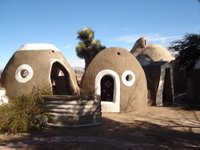 housing for people who had their homes destroyed. Jim Guerra, a man that my sister met with at the institute, is teaching the technique to migrant farm workers. He is also spearheading a push to get the structures approved by the State of California so that they can be built on farmers' lands, thus providing migrant farmers a place to sleep that is a lot better than park benches. Representatives from the United Nations and many other organizations have traveled to Hesperia to see the work that is being conducted.
housing for people who had their homes destroyed. Jim Guerra, a man that my sister met with at the institute, is teaching the technique to migrant farm workers. He is also spearheading a push to get the structures approved by the State of California so that they can be built on farmers' lands, thus providing migrant farmers a place to sleep that is a lot better than park benches. Representatives from the United Nations and many other organizations have traveled to Hesperia to see the work that is being conducted.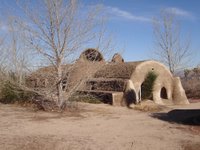 The basic techniques are also being further developed so that through a combination of building methods, full scale houses can be built. The institute is about 80% of the way through completing a 2500 square foot house for a total cost of about $90,000. It includes three bedrooms, two bathrooms, and a two car garage.
The basic techniques are also being further developed so that through a combination of building methods, full scale houses can be built. The institute is about 80% of the way through completing a 2500 square foot house for a total cost of about $90,000. It includes three bedrooms, two bathrooms, and a two car garage.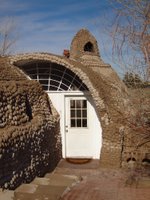
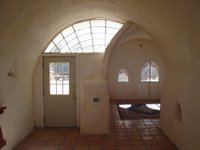
It should be noted the Hesperia is in the high desert at about 3700 feet and so it was really really cold. Especially for the weenie boy from Hawaii. I ended up hiding in the car, which was warm from sitting in the sun all morning and reading while my sister interviewed Jim about his ongoing efforts.
The trip to the Cal Earth Institute was extremely educational for me. I learned a lot about environmentally friendly architecture, but more importantly, I learned a lot about my sister and her interests.

No comments:
Post a Comment